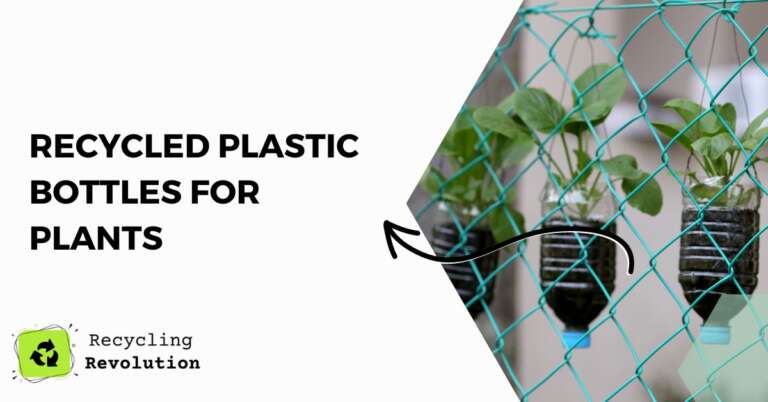Gardening offers a beautiful, fruitful, and sustainable way to interact with our environment. But, this green venture can be enhanced even further by leveraging an everyday waste product – recycled plastic bottles.
These humble materials that often end up in our bins can be transformed into a gardener’s goldmine, creating unique planters and ingenious watering systems for your green family.
In this article, we’ll explore how you can use recycled plastic bottles for plants in a variety of creative, effective, and sustainable ways.
TL;DR: Recycling plastic bottles for plants is a simple, cost-effective, and environmentally-friendly way to boost your gardening game. From self-watering planters to seed starters, the applications are vast and innovative.
Just remember: Always clean the bottles thoroughly, ensure proper drainage, and consider the plant’s needs when choosing your bottle size. Remember, every bottle saved is a step towards a greener planet.
🧴 Plastic Recycling Estimator
🔍 Plastic Buyback Facts
Most buyback programs accept PET (water bottles), HDPE (detergent containers), and PP (caps, cups). Light plastics like bags and wrappers are harder to recycle, but containers and jugs are highly valued. Recycling plastic reduces landfill overflow and saves fossil fuels.
The Benefits of Recycling Plastic Bottles For Plants
Recycling plastic bottles for plants doesn’t just help the environment by reducing waste; it also presents numerous advantages for both novice and veteran gardeners.
Economical and Accessible
Buying planters and pots can be quite an expense, especially if you have a large garden or numerous indoor plants. Plastic bottles, however, are readily available and free, making them an affordable option for gardeners on a budget.
Versatility
The variety of shapes, sizes, and types of plastic bottles means that you can find the perfect container for almost any plant. Whether you’re starting seeds or need a large container for a tomato plant, there’s a plastic bottle that can serve your needs.
Water Conservation
Many designs for plastic bottle planters involve self-watering systems. These allow plants to take up exactly the amount of water they need, reducing waste and ensuring your plants are always hydrated.
Recycled Plastic Bottles: A Step-by-Step Guide
1. Choosing and Cleaning Your Bottle
Pick a plastic bottle that fits the size of your plant. A 2-liter soda bottle can be great for larger plants, while a smaller water bottle will work for seedlings or small plants. Always make sure to wash and disinfect your bottle thoroughly before use.
2. Cutting and Preparing Your Bottle
Using a sharp pair of scissors or a craft knife, carefully cut the plastic bottle to create your planter. The design can vary, but it’s essential to ensure the plant will have enough space to grow.
3. Ensuring Proper Drainage
Punch holes at the bottom of your bottle planter to allow excess water to escape. This step is crucial to prevent waterlogging and root rot.
4. Filling and Planting
Fill your new planter with suitable soil for your plant species. Plant your seeds or transplant your plant into the bottle, ensuring it is well-settled into its new home.
5. Watering and Maintenance
Water your plant according to its specific needs. Remember to place the bottle planter in a location with appropriate light conditions.
Note: With self-watering planters, the top half of the bottle is inverted and filled with soil and the plant, while the bottom half is filled with water. A strip of cloth or yarn acts as a wick, drawing water up to the plant’s roots. This is an excellent method for people who tend to forget watering their plants or are going on vacation.
Alternative Uses of Recycled Plastic Bottles
Apart from using plastic bottles as planters, they can also serve other garden-related purposes.
- Seed Starters: Cut off the bottom of the plastic bottle, fill it with seed-starting mix, and sow your seeds. The remaining top part can act as a mini greenhouse, trapping in heat and humidity to help your seeds germinate.
- Watering Cans: Poke holes in the cap of a plastic bottle, fill it with water, and voila, you have a makeshift watering can. This is an excellent way to water seedlings gently without disturbing the soil.
- Hanging Planters: Secure a cut and cleaned plastic bottle to a string or wire and hang it up with a plant inside. Perfect for small spaces, balconies, or vertical gardens.
Advanced Bottle Planter Designs
Moving beyond the basics, there are various innovative designs that you can explore when using recycled plastic bottles for plants.
Self-Watering Systems
For those prone to forgetting to water their plants, a self-watering system can be a lifesaver. It involves using two halves of a plastic bottle.
Fill the bottom half with water, then invert the top half, fill it with soil, and plant your seedling. Using a piece of cloth or a string as a wick, water can be drawn from the reservoir to the plant, ensuring consistent moisture.
Vertical Gardens
Recycled plastic bottles also provide a fantastic way to create vertical gardens, ideal for those with limited space. To create a vertical garden, cut the bottles horizontally, fill them with soil, and attach them to a vertical surface such as a wall or fence.
These vertical gardens can be a perfect way to grow herbs, succulents, or other small plants.
Terrariums
Clear plastic bottles can also be used to create small terrariums. These enclosed environments can be perfect for growing a variety of plants, especially those that thrive in humid conditions, like ferns and mosses.
DIY Greenhouse
Lastly, recycled plastic bottles can be a great way to create a DIY greenhouse. By placing a cut-off bottle top over a plant, you can create a mini greenhouse that traps in heat and humidity, helping your plants grow.
This can be particularly useful for germinating seeds or growing plants that thrive in humid conditions.
Additional Tips and Considerations
In addition to the step-by-step guide provided above, there are some additional tips and considerations to bear in mind when using recycled plastic bottles for plants.
Understanding the Plant’s Needs
Different plants have different needs, and it’s important to match the plant to the size and type of bottle you’re using. For instance, if you’re planting a small succulent, a small plastic bottle will do.
However, if you’re planting a larger vegetable plant, like a tomato or cucumber, you may need a larger container, like a 2-liter soda bottle. Remember to take into account the plant’s future growth when choosing a bottle.
Ensuring Bottle Safety
Though plastic bottles are generally safe to use for plants, it’s crucial to ensure that they haven’t been used to store harmful chemicals.
Always clean and disinfect your bottles thoroughly before use, and if you’re unsure about a bottle’s previous contents, it’s better to err on the side of caution and not use it.
Proper Drainage
Creating drainage holes in your bottle planters is essential to prevent overwatering and root rot. Without these holes, water can accumulate at the bottom of your planter, leading to waterlogged soil and potentially killing your plants.
Note: It’s essential to create drainage holes that are large enough to allow water to escape but small enough to prevent soil from falling out. You can achieve this by layering a piece of fabric or a coffee filter at the bottom of the planter before adding soil.
Light Considerations
Many plants require plenty of light to grow, and plastic bottles can sometimes block light from reaching the soil and roots. For plants that need plenty of light, clear plastic bottles are the best choice.
You can also place your bottle planters near windows or under grow lights to ensure they receive enough light.
Conclusion
The art of gardening does not have to be an expensive venture. By employing creativity and a bit of recycling, we can create functional, cost-effective solutions to enhance our green spaces.
Using recycled plastic bottles for plants is a testament to this fact – an example of how waste can be transformed into something valuable and meaningful.
So next time you have a plastic bottle at hand, don’t throw it away. See it as an opportunity to expand your garden and contribute to a healthier environment. After all, each small step towards sustainable gardening is, indeed, a giant leap for mankind.
FAQs
Can all types of plastic bottles be used for plants?
Yes, but it’s essential to ensure they’re thoroughly cleaned to remove any residues. Clear bottles are best, as they allow light to reach the roots, which can be beneficial for certain plants.
Do I need to put holes in my bottle planter?
Absolutely, drainage is crucial for plant health. Without it, excess water can’t escape, leading to waterlogged soil and root rot.
Can I use plastic bottles for all types of plants?
While plastic bottles are versatile, they may not be suitable for all types of plants, especially larger ones. Consider the plant’s needs for space and growth when choosing your bottle size.

